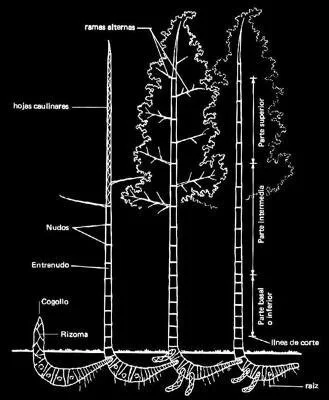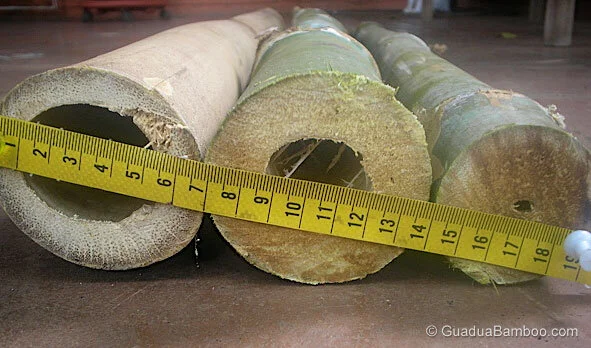
Bamboo Forum
From planting to building, browse questions and
trusted answers from real bamboo experts.
Encyclopedia or Database to Identify Bamboo Species
Is there a bamboo encyclopedia or database that has significant amount of information? Trying to identify some bamboo that I have, because I'm not exactly trusting the information where I got the bamboo from. Would like to compare data.
Is there a bamboo encyclopedia or database that has significant amount of information? Trying to identify some bamboo that I have, because I'm not exactly trusting the information where I got the bamboo from. Would like to compare data.
⭐ Best Answer:
Yes there is: Plants of the World Online - KEW
This is the most complete database with all currently known bamboo species. Unfortunately they don’t show a lot of images of the bamboo. Here on our website we do publish photos and descriptions of the most popular bamboo species so you might have more luck browsing our page.
What Determines the Length of Bamboo Internodes?
What determines the length of bamboo internodes? Is it the species only, or are there other factors involved?
What determines the length of bamboo internodes? Is it the species only, or are there other factors involved?
⭐ Best Answer:
The length of bamboo internodes varies greatly from species to species, and the climate and soil it is grown in. Also, bamboo internodes are much shorter towards the base and tip of the culm (stem) compared to the internodal length in the middle of the culm.
Generally speaking the more nodes, the stronger the bamboo. A bamboo culm is at its strongest at the base (largest diameter, more nodes, thickest walls), that's because it has to support the weight of the entire culm, branches and leaves.
So why are the internodes also short toward the tip of the bamboo? This has two reasons:
The branches grow from the nodes. Most bamboo species have little to no branches in the middle of the culm, but primarily at the top, and sometimes near the base. That's why there are more nodes and shorter internodes at the top.
Since there is a lot of weight from branches and leaves at the top, it also has to be strong and flexibel. Hence, lots of nodes and short internodes.
How Many Internodes Has an Average Bamboo Culm?
How many internodes has an average bamboo culm?
How many internodes has an average bamboo culm?
⭐ Best Answer:
In BAMBOOS OF THAILAND there are several tables in which the number of culm-nodes and their corresponding culm length above the ground, the number of internodes, their length, diameter and wall width are listed.
Such tables are available of the following species:
Bambusa pervariabilis, Bambusa textilis, three unidentified Bambusa species, Cephalostachyum pergracile, three unidentified Dendrocalamus species, Lingnania distegia, one unidentified Schizostachyum species, and ×Thyrsocalamus liang.
Guadua Bamboo Rhizome Morphology
I want to compare Guadua angustifolia and Ethiopian mountain bamboo in their rhizome morphology, but I become confused with the two different rhizome positions of Guadua angustifolia mentioned. I need clarification about rhizome forms of the species.
I read about two different rhizome positions of Guadua angustifolia (nearly vertically positioned rhizome with collective feet and horizontally positioned rhizome).
Here in Ethiopia, North East Africa, there is mountain bamboo that has a similar rhizome position (nearly vertically positioned) with collective rhizome feet. I want to compare Guadua angustifolia and Ethiopian mountain bamboo in their rhizome morphology, but I become confused with the two different rhizome positions of Guadua angustifolia mentioned.
I need clarification about rhizome forms of the species. I would appreciate it if you can show me pictures as well.
⭐ Best Answer:
I'm not exactly sure what you mean with vertical vs horizontal positioned rhizomes but I assume you are referring to Guadua's underground growth habit. So, I think the question should be: Is Guadua angustifolia a running or a clumping type of bamboo?
There is quite some confusion about the rhizome structure of Guadua angustifolia as Guadua species are classified as clumpers, however the reality is quite different...
The long-necked rhizomes can easily extend between 1 and 2,5 meters before turning upwards into a new culm, and outdistancing some bamboos with leptomorph (running) rhizome systems. Rather than "clumping" bamboo, Guadua bamboos are more properly characterized as having a pachymorph rhizome system with a diffuse habit (or "open clumpers") – though even this often understates the matter.
What is the Best Bamboo Species for Making Floors?
I am considering bamboo as a flooring material. Are some species better than others for bamboo flooring?
I am considering bamboo as a flooring material. Are some species better than others for bamboo flooring? Love your site. So informative. So readable. Keep up the good work!
⭐ Best Answer:
Choosing the right species for bamboo flooring is crucial, because the strength and hardness of bamboo fibers varies greatly between species. Generally, the best timber bamboos come from the genera Guadua, Dendrocalamus, Bambusa, and Phyllostachys.
The most widely used species in Asia is Moso (Phyllostachys edulis), while in the Americas the preferred species is Guadua (Guadua angustifolia). Both are excellent flooring bamboos, but they differ in fiber density, growth habits, and availability. You can see a comparison of both species here.
It is also worth noting that Moso Bamboo is among the hardest bamboo species in the world, making it highly suitable for flooring applications where durability is critical.
Is Beema Bamboo a Solid Bamboo?
I'm wondering about how true the claims of total solidity of some species or varieties of bamboo actually are. e.g. Bambusa balcooa var 'Beema'. Is it a case of mostly solid starting from the base up or total solidity? Or is it just an occasional occurrence even in monoclonal cultivars?
I'm wondering about how true the claims of total solidity of some species or varieties of bamboo actually are. e.g. Bambusa balcooa var 'Beema'. Is it a case of mostly solid starting from the base up or total solidity? Or is it just an occasional occurrence even in monoclonal cultivars?
I know this site refers to Guadua angustifolia but it is also one of the best bamboo resources I've found online in terms of plain presentation of facts rather than the standard sales pitch so I figured where better to ask.
⭐ Best Answer:
100% solid bamboo (the entire culm) doesn't exist as far as I know, except maybe for some small diameter bamboo in the genus Chusquea.
In the genus Guadua there also exist a near solid species called Guadua amplexifolia (see photo), which starts nearly solid at the base, however a small cavity the size of a pencil is still present. Towards the middle and top of the culm the bamboo becomes hollow again, although the wall thickness remains fairly thick.
Is Gigantochloa atter Stronger than Gigantochloa apus?
Is there a difference in the level of sturdiness or hardness between Gigantochloa atter and Gigantochloa apus? I am currently doing a project and need to decide on the specific bamboo species to be used. The project is investigating on which type of bamboo is a strong and sturdy bamboo that can withstand impacts during vehicle crashes.
Is there a difference in the level of sturdiness or hardness between Gigantochloa atter and Gigantochloa apus?
I am currently doing a project and need to decide on the specific bamboo species to be used. The project is investigating on which type of bamboo is a strong and sturdy bamboo that can withstand impacts during vehicle crashes.
I searched on the web and found that Gigantochloa atter and Gigantochloa apus are two commonly used bamboo species for construction purposes as they are strong. Is it possible to determine which of them is stronger than the other?
⭐ Best Answer:
I did some quick research online and found the following data in regards to the physical and mechanical properties of Gigantochloa apus and Gigantochloa atter:
The strength properties of Gigantochloa atter were tested in green (Moisture content 72.3%) and in air dry (M.C 14.4%) condition.
Average MOR varied from 87.9 to 108.1 N/mm2 from base to top in green and 117.7 to 127.7 N/mm2 in air dry.
Compression strength parellel to grain 24.77 to 27.97 N/mm2 in green, 32.87 to 30.98 N/mm2 in air dry.
Average tensile strength was 299.8 to 273.0 N/mm2 from base to top in green and 33.15 to 24.70 N/mm2 in air dry.
Average shear strength was 5.8 to 10.8 N/mm2 in green and 9.5 to 10.8 N/mm2 in air dry.
The strength properties of Gigantochloa apus were tested in green (Moisture content 54.3%) and in air dry (M.C 15.1%) condition.
Average MOR 102.0 in green and 87.5 N/mm2 in air dry, maximum crushing stress varies from 21.73 to 26.50 in green and 27.29 to 48.64 kN/mm2 in air dry.
Average tensile strength was 294.1 in green and 298.9 kN/mm2 in air dry.
Average shear strength in green varied from 5.99 to 7.68 whereas in air dry it was 7.47 to 7.65 kN/mm2.




